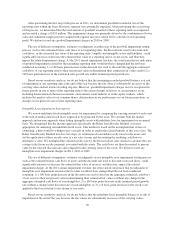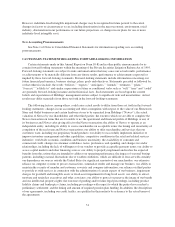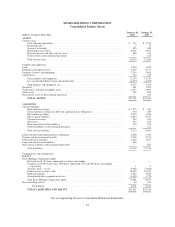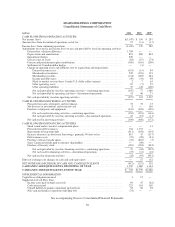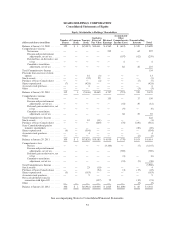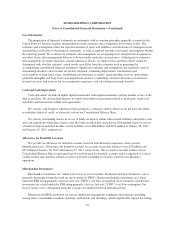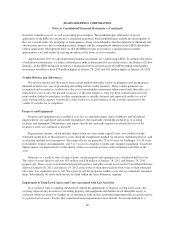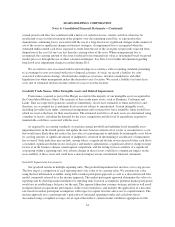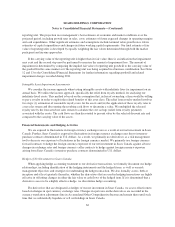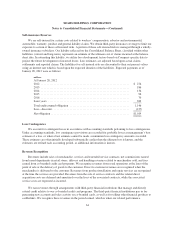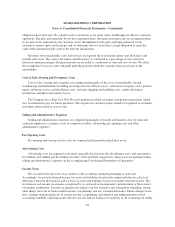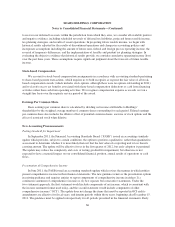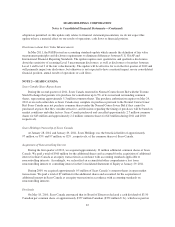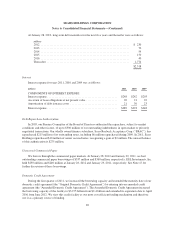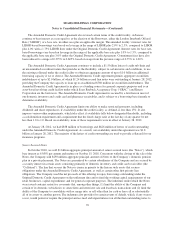Sears 2011 Annual Report Download - page 60
Download and view the complete annual report
Please find page 60 of the 2011 Sears annual report below. You can navigate through the pages in the report by either clicking on the pages listed below, or by using the keyword search tool below to find specific information within the annual report.SEARS HOLDINGS CORPORATION
Notes to Consolidated Financial Statements—(Continued)
inventory valuation at cost, as well as resulting gross margins. The methodologies utilized by us in our
application of the RIM are consistent for all periods presented. Such methodologies include the development of
the cost-to-retail ratios, the groupings of homogenous classes of merchandise, the development of shrinkage and
obsolescence reserves, the accounting for price changes and the computations inherent in the LIFO adjustment
(where applicable). Management believes that the RIM provides an inventory valuation that reasonably
approximates cost and results in carrying inventory at the lower of cost or market.
Approximately 49% of consolidated merchandise inventories are valued using LIFO. To estimate the effects
of inflation on inventories, we utilize external price indices determined by an outside source, the Bureau of Labor
Statistics. If the FIFO method of inventory valuation had been used instead of the LIFO method, merchandise
inventories would have been $70 million higher at January 28, 2012 and $42 million higher at January 29, 2011.
Vendor Rebates and Allowances
We receive rebates and allowances from certain vendors through a variety of programs and arrangements
intended to offset our costs of promoting and selling certain vendor products. These vendor payments are
recognized and recorded as a reduction to the cost of merchandise inventories when earned and, thereafter, as a
reduction of cost of sales, buying and occupancy as the merchandise is sold. Up-front consideration received
from vendors linked to purchases or other commitments is initially deferred and amortized ratably to cost of
sales, buying and occupancy over the life of the contract or as performance of the activities specified by the
vendor to earn the fee is completed.
Property and Equipment
Property and equipment are recorded at cost, less accumulated depreciation. Additions and substantial
improvements are capitalized and include expenditures that materially extend the useful lives of existing
facilities and equipment. Maintenance and repairs that do not materially improve or extend the lives of the
respective assets are expensed as incurred.
Depreciation expense, which includes depreciation on assets under capital leases, is recorded over the
estimated useful lives of the respective assets using the straight-line method for financial statement purposes, and
accelerated methods for tax purposes. The range of lives are generally 20 to 50 years for buildings, 3 to 10 years
for furniture, fixtures and equipment, and 3 to 5 years for computer systems and computer equipment. Leasehold
improvements are depreciated over the shorter of the associated lease term or the estimated useful life of the
asset.
Primarily as a result of store closing actions, certain property and equipment are considered held for sale.
The value of assets held for sale was $55 million and $36 million at January 28, 2012 and January 29, 2011,
respectively. These assets were included in prepaid expenses and other current assets in the Consolidated Balance
Sheets at January 28, 2012 and January 29, 2011 at the lower of their historical net book value or their estimated
fair value, less estimated costs to sell. We expect to sell the properties within a year and we continually remarket
them. Substantially all assets held for sale are held within the Sears Domestic segment.
Impairment of Long-Lived Assets and Costs Associated with Exit Activities
In accordance with accounting standards governing the impairment or disposal of long-lived assets, the
carrying value of long-lived assets, including property and equipment and definite-lived intangible assets, is
evaluated whenever events or changes in circumstances indicate that a potential impairment has occurred relative
to a given asset or assets. Factors that could result in an impairment review include, but are not limited to, a
60


